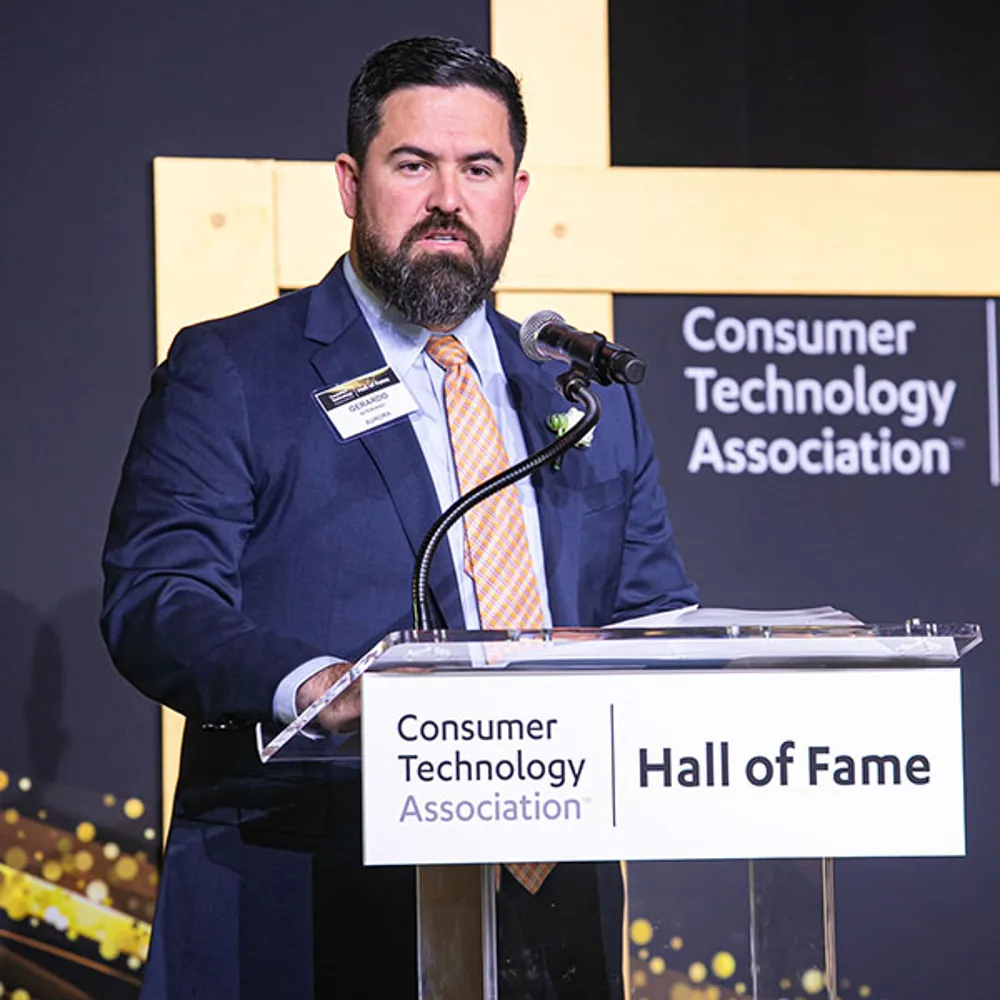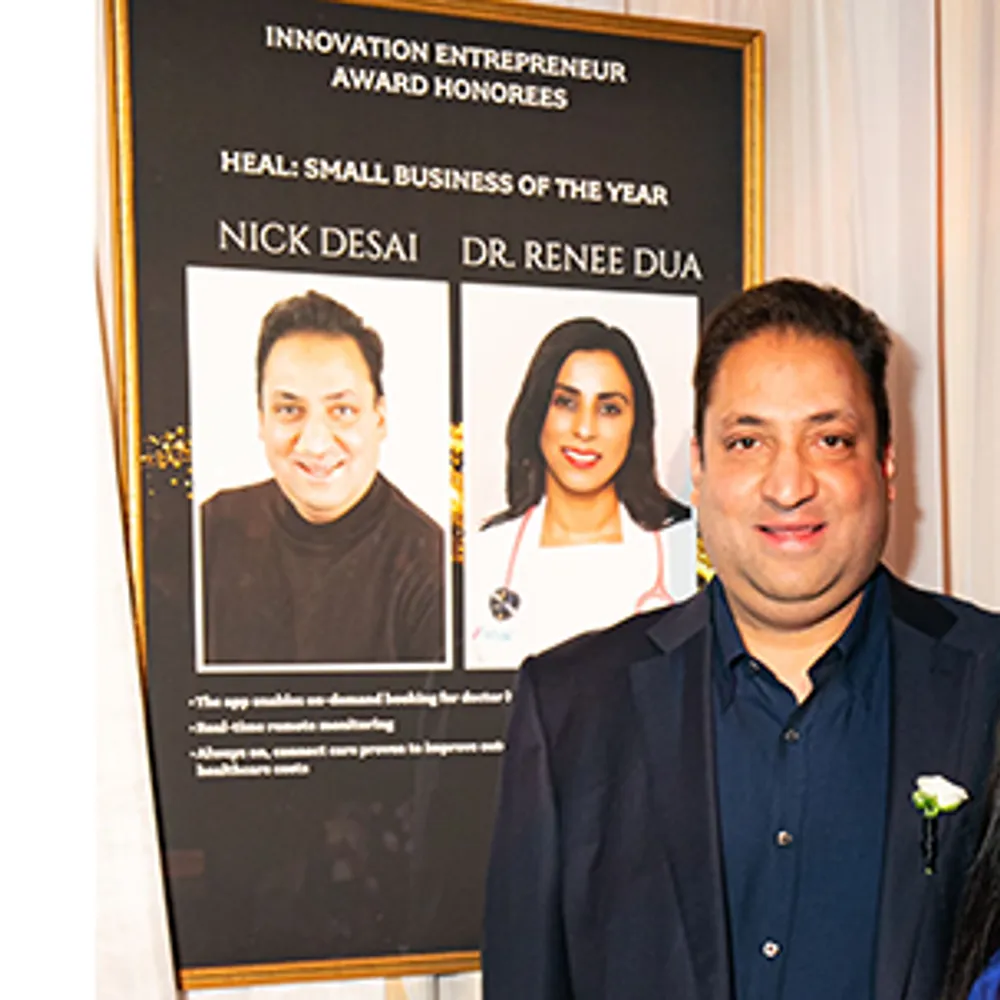Innovation Entrepreneur Awards Life-Changing Tech
December 12, 2019
- Author: Stewart Wolpin


November/December 2019
More articles in this issue:
Sponsored by It Is Innovation (i3) magazine and the CTA Small Business Council, the Innovation Entrepreneur Awards program recognizes inspiring entrepreneurs, leading businesses and exceptional startups in the consumer technology industry. Executives and leading businesses with revenues under $30 million and the contributions they make to the U.S. economy are recognized with these awards.
For the first time, CTA also honored its Innovation Entrepreneur Award (IEA) winners at the dinner, recognizing a leading business and an exceptional startup in the consumer technology industry.
Sponsored by It Is Innovation (i3) magazine and the CTA Small Business Council, the Innovation Entrepreneur Awards program recognizes inspiring entrepreneurs, leading businesses and exceptional startups in the consumer technology industry. Executives and leading businesses with revenues under $30 million and the contributions they make to the U.S. economy are recognized with these awards.
For the first time, CTA also honored its Innovation Entrepreneur Award (IEA) winners at the dinner, recognizing a leading business and an exceptional startup in the consumer technology industry.

Startup of the Year: Aurora
Imagine you’re driving on the highway when something tumbles out of a truck in front of you. You can’t quite see what it is, but you immediately recognize the object as a danger and react accordingly.
Machines are, obviously, not human. They only know what they have learned, so they have no capacity to react once confronted by the unknown. A self-driving vehicle may "see" something fall off the back of a truck but, it also must be able to identify or categorize the object as "dangerous" so the vehicle can act accordingly. Being able to perceive random, infrequent and unique road events is called the long-tail phenomenon.
Since 2017, the self-driving technology company Aurora has been developing the Aurora Driver, a platform made up of software, hardware and data services to allow a vehicle to drive itself. Development includes compensating for the long-tail phenomena, to enable self-driving vehicles to better recognize and react to the unknown hazards on the roads and make these cars as safe as possible for occupants of the vehicle, surrounding vehicles and their passengers, and pedestrians.
“Safety isn’t just a theoretical concept or a talking point we put on our website. We have human lives in our hands, and that’s something we never forget,” said CEO Chris Urmson. Aurora plans to develop technology that never gets tired or distracted.
Aurora's technology, including its focus on perfecting a driverless vehicle's perception and its culture of safety, has earned Aurora the 2019 CTA Innovation Entrepreneur Award for “Start-Up of the Year.”
Aurora's founders – Chris Urmson, Drew Bagnell and Sterling Anderson – are kind of an AV supergroup, each having spent years working on autonomous vehicle technology. Urmson and Bagnell, Aurora’s CTO, were robotics Ph.D. students at Carnegie Mellon together, then established their own prominent places in the autonomous vehicle ecosphere.
Urmson helped start and served as CTO for Google's self-driving car program, while Bagnell became a research scientist at Carnegie Mellon's highly regarded Robotics Institute and worked in Uber's autonomous vehicle division. Anderson, Aurora’s chief product officer, developed the MIT Intelligent Co-Pilot, then led the design, development and launch of the Tesla Model X and Tesla Autopilot. When Urmson left Google, he saw a unique opportunity to build a new mobility system, one that moves people and goods safely and efficiently, so he teamed up with Anderson and Bagnell.
Since its founding, Aurora has grown to 400-plus employees with offices in Pittsburgh, PA, Palo Alto, CA, San Francisco, CA and Bozeman, MT, has established partnerships with Fiat-Chrysler, Hyundai and Kia, raised more than $600M from investors like Amazon, and tests vehicles in Pittsburgh and California.
One-way Aurora ensures its vehicles drive safely is by developing systems to account for objects it doesn't recognize, a development process Aurora calls “No Measurement Left Behind.”
"We designed our system to ensure that all of our sensor measurements have an explanation," Urmson explains. "We’re blending state-of-the-art machine learning and engineering in our perception system to help the Aurora Driver handle the unexpected. This improves safety because when the Aurora Driver knows something is there, it can react."
Aurora is developing the Aurora Driver to work seamlessly across all vehicle platforms, similar to a computer or smartphone operating system, that any car maker can adopt.
This dedication to making our roads safer remains a key factor for Aurora's efforts. "We will deploy Aurora Driver when it's safer than a human driver," Urmson insists.

Heal: CTA Small Business of the Year
Many consumer technologies are metaphorically described as lifesavers. But Heal, an app-powered service rejuvenating antiquated doctor house calls, literally does save lives.
Take, for example, the 72-year-old woman with COPD who couldn't get to a doctor. Heal doctors coming to her home to treat her "saved my family." Or the 54-year-old man with diabetes who had his left leg amputated and couldn't get to his endocrinologist. The Heal physician transitioned him from an insulin pump to subcutaneous insulin and used Heal's in-home monitors to meticulously manage and control his blood sugar levels. Or the Heal provider who showed an 87-year-old woman suffering from COPD with a persistent and debilitating cough how to correctly use her pulmonary pump to provide her life-saving medication.
These lifesaving capabilities have earned Heal the 2019 CTA Entrepreneur of the Year award.
Heal was born out of personal frustration with existing medical care. On a Friday night in September 2014, nephrologist Dr. Renee Dua and her husband, entrepreneur Nick Desai, spent over six hours in an ER with their ailing 9-month-old son. "The resident didn't even know how to use an infant blood pressure cap," said Desai. "I said to my wife, 'we have to make health care easier'."
Two weeks later, Desai, while sitting in a burrito restaurant in Marina Del Rey, had a brainstorm for a visiting doctor service. After showing his wife a demo of an app, he'd worked up, Dr. Dua exclaimed: "We're quitting our jobs and doing this right now." Within three weeks, Desai had raised $1.5 million in angel capital. "Literally everyone we pitched, including Lionel Richie and U.S. French Ambassador Jamie McCourt, said yes instantly." The company launched Heal in October 2014 in LA, Washington, D.C., and northern Virginia.
The Heal idea is both simple and potentially revolutionary. A patient can request a house call from the Heal app or website, providing their insurance information and medical history online. Heal's visits are priced at $159 and charged to a patient's credit card, so there are no bills. However, insured patients usually pay nothing for preventative care and just a $5-$30 co-pay for sick care. A patient will know exactly what their out-of-pocket costs will be up-front, before the provider arrives, usually in less than two hours.
Nearly 60 licensed providers have signed up with Heal, working 16 8am-8pm shifts a month, each paired with a driver to allow for between-visit time for completing pre- or post-visit paperwork on a tablet or laptop or reviewing or amending a patient's electronic medical records.
Heal also offers the Heal Hub, a nightlight-sized Bluetooth device that connects to around 175 biomedical devices. Heal Hub monitors, collects and uploads biomedical data to a patient's EMR to keep Heal's providers up to date. "How much knowledge a doctor has before seeing a patient, so that each visit with a doctor is as comprehensive as possible, enables those patients to have the best health outcomes possible," explains Dr. Dua, Heal's chief medical officer.
Heal has added coverage to broad swaths of California, Atlanta and New York City, and hopes to cover 75% of the U.S. population within the next four years. To date, Heal has made 150,000 doctor house calls, and will likely deliver about 100,000 house calls this year.
"It’s extremely rewarding," Desai reports. "People get the kind of healthcare that they need and deserve. Their response to Heal is a heart-warming personal joy that is hard to measure on a balance sheet."
Join our community of innovators and shape the future of technology.



